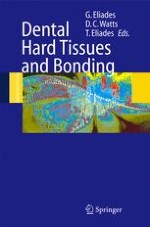2005 | OriginalPaper | Hoofdstuk
4. Orthodontic Bonding to Wet Enamel with Water-Insensitive and Water-Activated Orthodontic Adhesive Resins
Auteurs : T. Eliades, G. Eliades, N. Silikas, D.C. Watts
Gepubliceerd in: Dental Hard Tissues and Bonding
Uitgeverij: Springer Berlin Heidelberg
